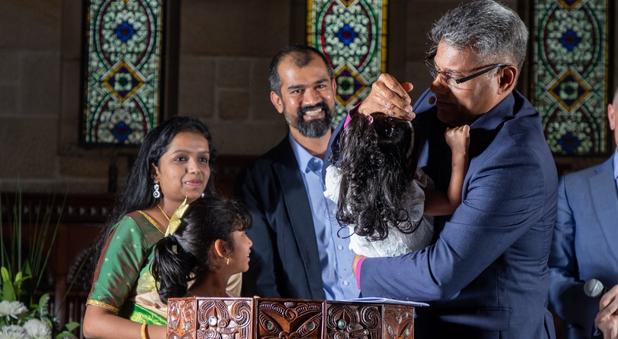Now there were staying in Jerusalem God-fearing Jews from every nation under heaven. When they heard this sound, a crowd came together in bewilderment, because each one heard their own language being spoken (Acts 2:5-6).
It wasn’t exactly the Day of Pentecost, but a celebration of baptisms and confirmations last month at St John’s Cathedral, Parramatta was all the more joyful thanks to new live-translation technology.
The cathedral has a celebration each year when its congregations join together, but until now it has been solely in English. This year, a team of translators used a phone app called LiveVoice to simultaneously broadcast Mandarin, Cantonese and Farsi translations of the English language livestream. There were more than 35 baptism and confirmation candidates, with hundreds inside the cathedral and in the square outside.
35 people were baptised or confirmed
According to the cathedral’s senior assistant minister, the Rev David Ould, the beginning of the event was not promising.
“On the day we actually got rained on,” he says. “So we started indoors and then had the overflows watching the livestream video. But God in his kindness caused it to clear, so we were all able to get outside right at the end and do all the immersion baptisms outdoors in a wonderful break in the weather.”
The annual event had been interrupted by the pandemic so everyone was grateful to be back.
“We waited because of COVID – we've waited 2½ years since the last one – so it was great to make it happen again,” Mr Ould says. “It was proof positive that God had been at work even during the difficult COVID season. Many of those who were being baptised or confirmed were conversions from the last two years.”
He adds that the translation technology was a first for the cathedral. “We were nervous about it, but it worked really, really well. We had a small team who had the scripts in advance and were rendering it, live, in their own language.”
Cathedral member Adrian Ng was co-ordinator of the translation broadcast. “We have basically three different language groups, so it's nice for us to be able to sit together and witness the baptism and still have everybody understand and follow along,” he says.
“The sermon by the Archbishop was in English and it was translated into Cantonese, Mandarin and Farsi. It's almost like the UN. You'd watch it in the native language and if you wanted you could go the app to listen in a different language.”
One of the testimonies was in Mandarin only, which was then translated live to English and Farsi (Persian). “It is very straightforward, even for the translator,” Mr Ng says. “The LiveVoice app just broadcasts the translation as the translators talk into their phones. For the listener, there's an app for your phone, or you could even just use a web browser and listen in.”
The cathedral team was aware that other churches had used similar apps but, Mr Ould says, “I think it's probably the first place, I'd say for miles around, where we've been doing it into multiple languages at the same time. Even with our change of plans, switching to indoors and having to move the team to a different location, they did brilliantly well.”
It's probably the first place, I'd say for miles around, where we've been doing it into multiple languages at the same time.
Welcomed in
A number of other parishes have experimented with live translation, including Rouse Hill in northwest Sydney. The outreach pastor at Rouse Hill, the Rev Rick Mason, says the church believes that the translation of services is a sign of welcome.
“On our table that everybody walks past as they enter, we have A5 laminated colourful cards in Chinese with instructions on how to get access to our Chinese downloads of the sermon and Bible readings,” he says.
“As we welcome people at the gate, and it becomes apparent that English isn't their heart language that they're comfortable with, we'll make sure that they get one of these cards so that they at least know there is a translation available. We hope that makes them feel like they're welcome and are being cared for.”
Not having a separate Mandarin service, the church uses another app, Mixlr, for live translation.
“We had a translator who would race upstairs just before the Bible reading, put on headphones so they could hear what was happening downstairs and then connect to the app [to broadcast live],” he explains.
“We’ve got a translation team of about six people, and they felt during the pandemic that it was a burden to have to be doing a live translation. [They asked] whether they could just translate the Bible passages and sermon beforehand and then upload that to the church website, so that's what we've been doing since then.”
Even though it is not live, Mr Mason thinks the effect is the same. “Before the Sunday service, the translations are all up on our website. People can listen to it from there, either simultaneously if they want to, or in their own time.
"We want people to be able to listen to it in their heart language"
“Feedback from people is that they are happy to listen to English and if there's stuff they struggle to understand they download and listen to it later.”
The benefits of translation, either live or recorded, are not just confined to the hearers. “The feedback from our translators was that they are growing a huge amount in their own maturity and understanding as they translate a sermon,” Mr Mason says.
“I've offered every now and again to our translators that if you're finding it stressful, you don't have to be doing it. They've all said ‘No, no, we're really happy. We are finding it helpful to do ourselves, and we want people to be able to listen to it in their heart language.’”
Just like in Acts.

















